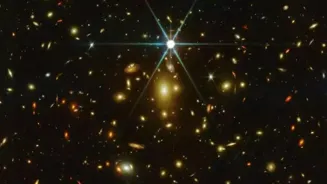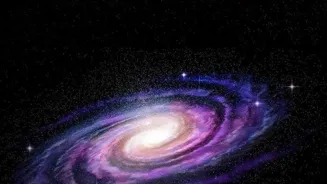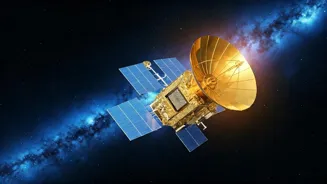Here are today’s most important updates from the realm of Science and Space.
Farthest Light, Fading Truth: Webb Sheds Doubt on Earendel’s Star Status
The most distant star ever discovered may have been misclassified: Instead
of being a single star, the object — nicknamed Earendel from the Old English word for "morning star" — may be a star cluster, a group of stars that are bound together by gravity and formed from the same cloud of gas and dust, new research suggests. Discovered by the Hubble Space Telescope in 2022, Earendel was thought to be a star that formed merely 900 million years after the Big Bang, when the universe was only 7% of its current age. astronomers used the James Webb Space Telescope (JWST) to take a fresh look at Earendel. They found that Earendel's spectral features match those of globular clusters — a type of star cluster — found in the local universe.
Cosmic Eclipse: Titan Casts a Giant Shadow Across Saturn

One of the solar system’s rarest and most breathtaking sights are currently visible: the massive shadow of Titan, Saturn’s largest and most enigmatic moon, sweeping across the face of the ringed planet. The spectacle that will only be available a few more times before it vanishes from view for almost two decades. Saturn's moon Titan is so big that you could fit roughly twenty-five Indias on the surface. Shadow transits like these only occur during Saturn’s equinoxes, when the sunlight hits the planet’s rings and moons nearly edge-on. Each transit lasts several hours, offering patient observers a generous window to fine-tune their views and experiment with astro-photography settings.
Your Heart vs. the Sun: Solar Bursts Tied to Blood Pressure Spikes

A new study has revealed that disturbances in the Earth’s magnetic field, triggered by solar activity, may have a surprising impact on human health, particularly on blood pressure. The findings suggest that blood pressure levels rise and fall in patterns that mirror the intensity of geomagnetic disturbances. The effect appears to be stronger during years of heightened solar activity, when geomagnetic storms are more frequent. In such periods, blood pressure responded more quickly to changes in the geomagnetic environment. Women’s blood pressure, in particular, was found to be more sensitive to these shifts compared with men.
Toxic to Tooth-Friendly: PFAS Chemicals Converted into Fluoride

Scientists have developed a new method to break down harmful "forever chemicals" by exposing them to a sunlight-activated material. Perfluoroalkyl and polyfluoroalkyl substances (PFAS) are chemicals found in many household products, including cookware, cosmetics, dental floss and waterproof clothing. True to their nickname, the chemicals take thousands of years to break down, enabling them to accumulate in the environment and our bodies. After mixing the material with one common PFAS called perfluorooctane sulfonate (PFOS), the researchers watched as the photocatalyst absorbed light to generate free radicals that attacked the fluorine atoms in the bond. Under optimized conditions, this led to the "complete breakdown" of around 99% of the PFOS molecules. The byproducts were components which the scientists say can be isolated and used to make toothpaste and fertilizer additives.















